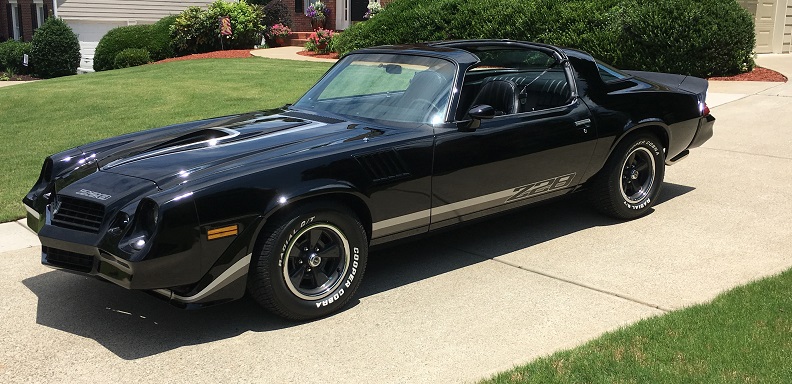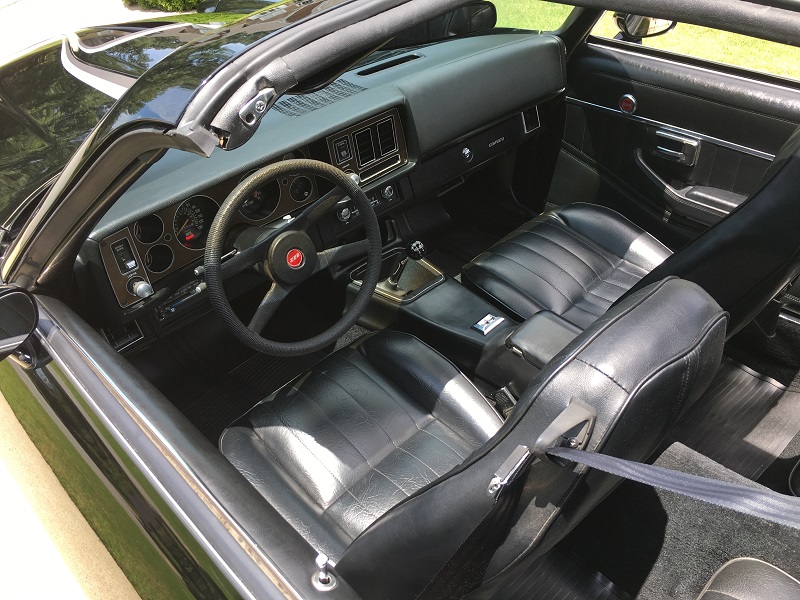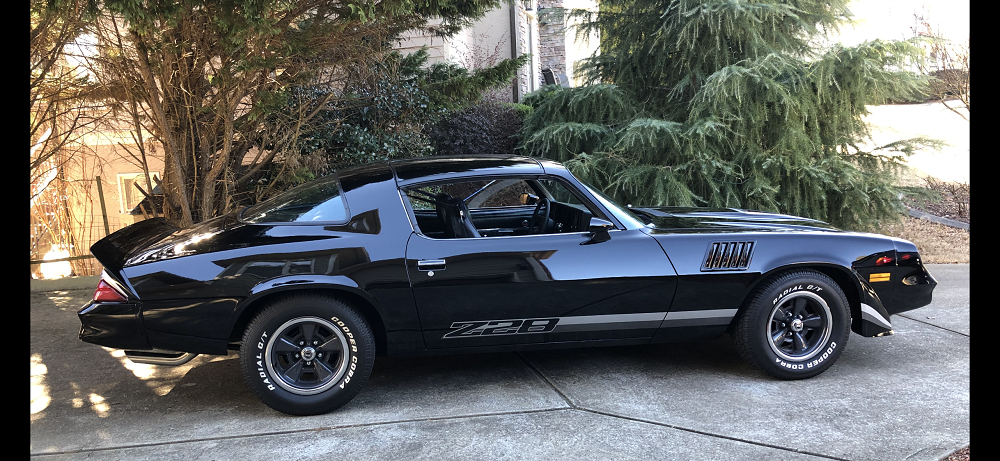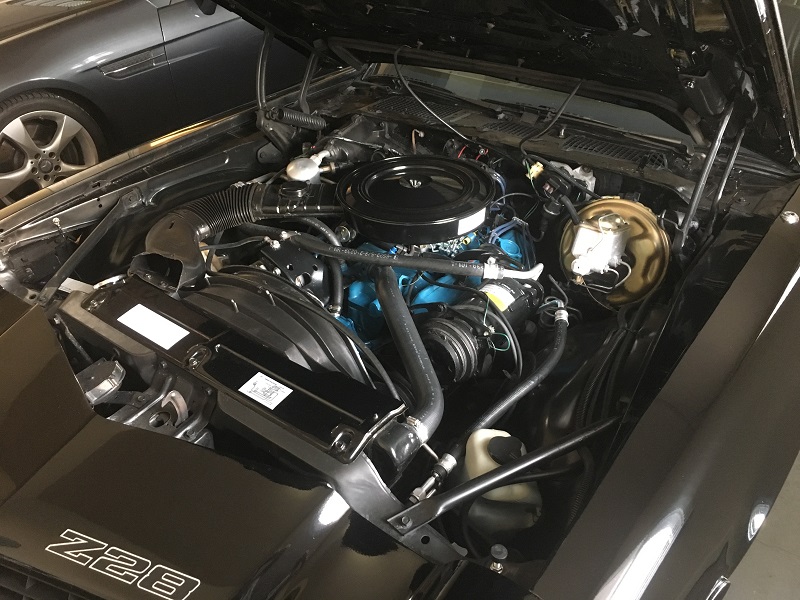For Fan Car Friday this week we bring you Michael and his wonderfully dark 79 Camaro Z28. Fan Car Friday is a segment where we want to share with the world the automobiles that our fans have. We have absolutely no affiliation/relationship with the cars, the build or the owners. This post was made with written consent from the owner.

“Just a little background on my 79 Z28. I was 11 when the original owner bought it new. I have known the car it’s whole life. Very low mileage car just needed to be restored. I’ve spent the better part of six years putting it back together. Black on black t top 4 speed car. What more can you ask for. It is all numbers matching but the motor has be built up. Last roller dyno it pushed 375hp to the rear wheels. Not crazy but still fun.
The car belonged to the gentleman who owned the local gas station in my hometown in Wisconsin. It was stored correctly during the winters so amazingly it is a rust free car. I live in Georgia now so the car was brought here and refreshed. I’ve tried to keep the appearance as original as possible but as I said earlier the motor is numbers matching but built. It’s now a full roller motor with aluminum heads and intake. Demon carb and headers with Pypes exhaust. Everything is painted corporate blue and all decals where replaced to give the engine bay a very factory look. The car has factory ac that still runs on Freon. (Never converted) over all I think it’s a nice representation of what a 79 Z28 should be. One last thing even though the motor was rebuilt it is a low mileage car. 49k as it sits now.”

Dubbed “Super Hugger”, the second-generation Camaro was developed without the rush of the first generation and benefited from a greater budget justified by the success of the first generation. Although it was an all-new car, the basic mechanical layout of the new Camaro was familiar, engineered much like its predecessor with a unibody structure utilizing a front subframe, A-arm and coil spring front suspension, and rear leaf springs.
The chassis and suspension of the second generation were greatly refined in both performance and comfort; base models offered significant advances in sound-proofing, ride isolation, and road-holding. Extensive experience Chevrolet engineers had gained racing the first-generation led directly to advances in second-generation Camaro steering, braking, and balance. Although it began its run with a number of high-performance configurations, as the 1970s progressed, the Camaro grew less powerful, succumbing, like many production cars of the era, to the pressures of tightening emissions regulations and a fuel crisis. Major styling changes were made in 1974 and 1978; 1981 was the final model year for the second-generation Camaro.

The biggest changes for 1979 were the introduction of the luxury-oriented Berlinetta model, replacing the Type LT, and a restyled instrument panel with a much flatter appearance than the previous wraparound design (although the gauges themselves remained in the same places as before). The base models, RS and Z28 remained, the Z28s now came with a front spoiler and fender flares much like its Pontiac Trans Am twin had, and now came with “Z28” decals that ran from the beginning of the front flares to the bottoms of the doors. Electric rear window defroster became optional this year, replacing the old blower type. Sales for 1979 were the highest ever for any generation Camaro before or since, numbering 282,571 units. Engine choices remained with the 250 I6 standard in the base and RS models, with the 305 2bbl being an option and standard on the Berlinetta.
https://en.wikipedia.org/wiki/Chevrolet_Camaro_(second_generation)

Want your car to be featured as one of our Fan Car Friday’s post? Know somebody that might? Use the contact link at the bottom and email us a couple of photos as well as your contact information and your vehicle could be featured on an upcoming Friday post. Please make sure to put FAN CAR in the subject heading.
I owned a 1978 Maroon Z28. I really loved that car. Stock engine had less than 200hp but the torque was way higher. I actually tweaked the quadrajet, created a fully functional hood scoop, added true dual exhaust, it went to around 235 hp! You could actually hear & feel the cam come in at around 2800 RPM!
GREAT CAR!
Beautiful car. So happy to see more and more folks out there keeping the past in the future.
Love and miss the past !!!!!
I can really relate to this. I bought a 1980 Z28, Black on gold and I loved this car. Unfortunately, family came along and I had to sell it. Would love to get my hands on another one now
How can I buy this car?
I ordered my1979 Z28 Camaro in October of 1978 from the factory, and received it from the factory in April of 1979…drove it for twenty years, stored it for twenty years, and have just completed a full rotisserie all numbers matching complete restoration …#19 Tuxedo Black, Delux Black Cloth, Tilt Wheel, Electric Windows, 4 speed, Radio Delete…(Still Radio Delete)….it is now a far better built car than it ever was from the factory or the day I received it, all in original colours….Vancouver Canada.
Do you want to sell?
That took a long time to get. I ordered mine in September of ’78 and got it December 8th of ’78. I was there for the delivery. I was off that day. It was Dark blue (29L), NO T-TOPS! Oyster interior. I had to get an automatic because of insurance. I still have it. It has a little over 60K miles. https://rkbnet.com/camaro